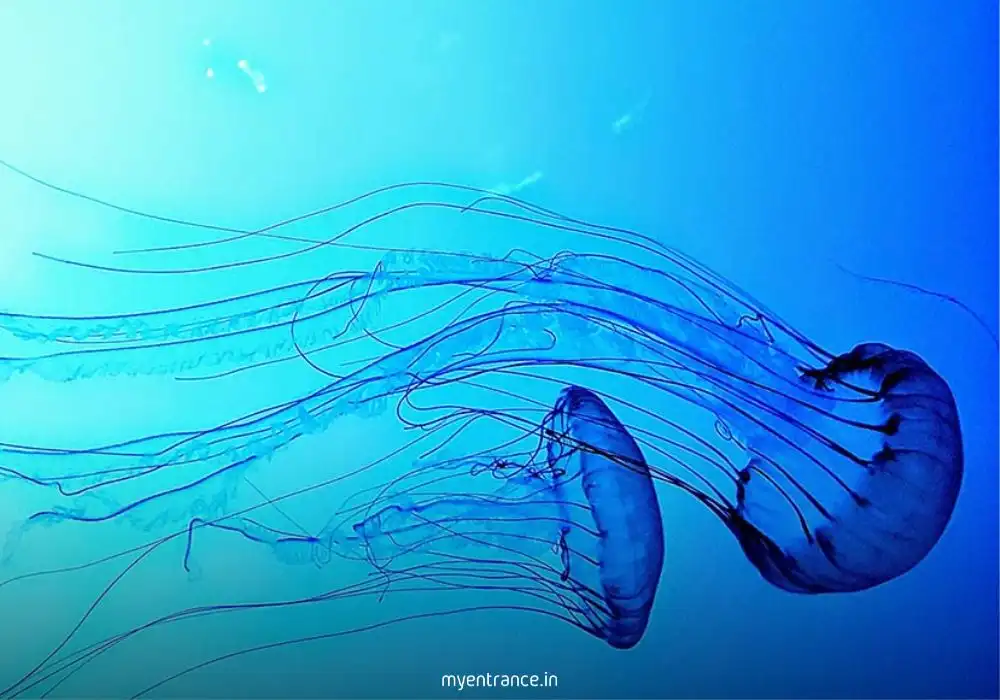Translate Language
Box Jellyfish: Why It’s Earth’s Most Venomous Marine Creature
Picture yourself swimming in warm, tropical waters – a scene of paradise. But beneath the surface lurks an invisible menace: the box jellyfish. Delicate and nearly transparent, this creature’s beauty masks a lethal secret. For competitive exam students (UPSC, SSC, NIFT, etc.), understanding this marine marvel isn’t just about biology; it’s about grasping real-world science and survival tactics. Let’s unravel why this “sea wasp” is nature’s ultimate paradox of elegance and deadliness.

The Box Jellyfish: Anatomy and Behavior
Unique Physical Traits
Unlike common jellyfish, the box jellyfish (class Cubozoa) stands out:
Bell shape: A transparent, cube-like body up to 30 cm wide.
Tentacles: Up to 10 feet (3 meters) long, armed with millions of nematocysts – microscopic venom-injecting harpoons.
Movement: Agile swimmers (unlike drifting jellyfish), using a muscular velarium to propel themselves at 4 mph (1.5 m/s).
Habitat
Found in warm tropical oceans, often near coastlines. They hover below the water’s surface, making them hard to spot – a silent threat to swimmers.
Why Is Its Venom So Deadly?
Unmatched Toxicity
The Australian species Chironex fleckeri (nicknamed “sea wasp”) is the world’s most venomous marine animal. Its venom:
Destroys cells: Creates pores in cell membranes, causing potassium leakage.
Triggers cardiac arrest: Can stop a human heart in 2–5 minutes.
Rapid tissue necrosis: Causes severe scarring or limb damage even in survivors.
Fatal Statistics
A single jellyfish carries venom potent enough to kill 60+ adults.
69+ deaths recorded in Australia since the 1800s (Environmental Literacy Council).
50–100 global fatalities yearly from stings.
Speed of Attack
Medical experts describe the venom’s impact as “blinding speed”:
Cardiovascular collapse occurs almost instantly.
Delayed treatment often leads to permanent disability (e.g., chronic pain, mobility loss).
The Sting: Symptoms & Immediate Risks
Contact with tentacles triggers nematocysts to fire venom into the skin. Victims experience:
Physical agony: Burning pain, whip-like welts, and muscle cramps.
Systemic reactions: Nausea, headaches, hypertension, or cardiac arrest.
Long-term trauma: Psychological distress (PTSD) or recurring pain.
First Aid & Prevention: Life-Saving Protocols
Critical First Response
Vinegar (acetic acid): Douse the sting site within 30 seconds to neutralize unfired nematocysts.
DO NOT rub the wound: This triggers more venom release.
Emergency care: Rush to a hospital – antivenom must be administered within minutes to prevent death.
Proactive Safety Measures
Protective gear: Wear full-body lycra suits or wetsuits in “stinger season” (October–May in tropics).
Avoid high-risk zones: Heed warning signs in Australia, Thailand, or the Philippines.
Never touch washed-up tentacles: They remain toxic for weeks.
Scientific Breakthroughs: Hope on the Horizon?
Researchers at the University of Sydney used CRISPR gene-editing to develop a molecular antidote:
How it works: Blocks venom’s cell-destroying mechanism.
Limitations: Must be applied within 15 minutes; unclear if it prevents cardiac failure.
Future potential: Could revolutionize treatment in remote coastal areas.
Why This Matters for Competitive Exams
UPSC/SSC relevance: Questions on marine toxins, CRISPR, or first aid feature in GS papers.
Real-world context: Rising coastal tourism and climate change are expanding jellyfish habitats.
Key takeaway: Awareness saves lives – never swim unprotected in tropical waters during stinger season.
Final Thought: The box jellyfish embodies nature’s ruthless precision. For aspirants, it’s a case study in biology, ecology, and human resilience. Stay informed, stay safe!
Get 3 Months Free Access for SSC, PSC, NIFT & NID
Boost your exam prep!
Use offer code WELCOME28 to get 3 months free subscription. Start preparing today!














